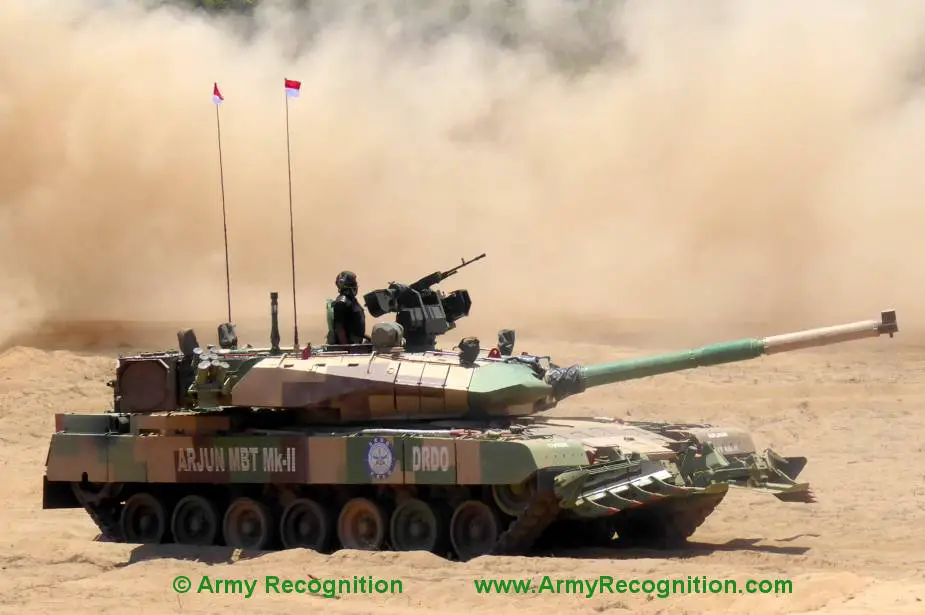Arjun Mk1A (also designated MkII, it appears) is the latest version of the Arjun Tank built by the Combat Vehicles Research and Development Establishment (CVRDE) and other DRDO research facilities. It is an upgraded version of the Arjun platform, with increased firepower with automated target tracking capabilities, maneuverability, and survivability (thanks to its ERA and Kanchan Indian modular composite armor), designed and developed by India’s Defense Research and Development Organization (DRDO).
Follow Army Recognition on Google News at this link

Arjun Mk1A (or Mk.II) is receiving a fire control system benefiting from basic Artificial Intelligence to detect, track and engage targets (Picture source: Army Recognition)
According to Ashish Dangwal in The Eurasian Times, the Banglore-based company Tonbo Imaging is building its fire control system that uses Artificial Intelligence, in collaboration with the state-run Bharat Electronics Limited (BEL) plant in Chennai, India.
According to its own words, ”Tonbo Imaging is partnering with BEL, Chennai, to meet [BEL’s] demand for fire-control systems. Hence, BEL awarded us a contract to manufacture and deliver the [electro-optical fire-control system] for Arjun Mk1A MBTs”.
The Elpeos fire-control product will be delivered as part of the deal and integrated into the Arjun Mk1A tanks. According to the Tonbo Imaging website, ELPEOS is a multi-sensor electro-optical device developed for precision targeting and easy integration into remote-controlled weapon systems (RCWSs), V writes. ELPEOS has a cooled MWIR imager with high resolution, a color CCD camera, a Laser Range Finder, and an integrated ballistic computer. For target acquisition and georeferencing, it can optionally incorporate a GPS and a Digital Magnetic Compass with an inclinometer. This system makes it easier for tanks to acquire, lock, and engage moving targets using human or automatic tracking. Tonbo Imaging told EurAsian Times that “the system is one of the lightest sighting systems for RCWS equipped with an advanced AI processor capable of detecting, tracking and engaging the 12.7mm gun on identified targets. It has also been supplied to a few global armies for the 12.7mm weapon. The ELPEOS sighting system has been qualified in summer and winter trials. It is a sensor-fused system. So you can see day and night imagery in the same video feed,” Tonbo Imaging added.
As reported by Ashish Dangwal, Tonbo Imaging also informed EurAsian Times about the system’s three silent features, which are as follows:
1. Automatic target detection, tracking, and classification
2. Low power consumption and weight
3. Free from foreign export and licensing requirements and India’s only indigenous RCWS sighting system
In September 2021, India announced the procurement of 118 homegrown Arjun Mk1A tanks for the Indian Army. With various cutting-edge technology systems, the Mk1A is outfitted with precise and superior firepower, all-terrain mobility, and unbreakable multi-layered protection.
Aside from the standard armor-piercing fin-stabilized discarding sabot (APFSDS) and high explosive squash head ammunition, it also has integration for thermobaric and penetration-cum-blast ammunition.
The Arjun Mark 1A is said to have a maximum cruising range of 500 kilometers and a top speed on the road of 58 kilometers per hour and 40 kilometers per hour in cross-country.
The Arjun MK II or MK1A is powered by a German MTU V-90 turbocharged, water-cooled diesel engine producing 1,030 kW at 2,400 rpm. The Arjun Mk II has an epicyclic gearbox, a hydrodynamic torque converter, a mechanical lock-up clutch, a hydrodynamic retarder, and four forward and two reverse gears.
Artificial Intelligence for combat vehicles and troops on foot
It clearly appears that fitting an artificial intelligence system in serial on combat vehicles or supplying it to troops fighting on foot becomes a ‘must’ to instantly identify an enemy vehicle and, hence know its technical characteristics (strengths and weaknesses), which then enables the weapon operator (be it a gun or a missile launcher) to decide if and how to engage the target. A simple device like a mobile phone is sufficient to aim at the target but this device must have a protected datalink with a rich and powerful database operating with a software designed to identify the target on the basis of millions of pictures continuously uploaded in the database to enrich it and improve the e-learning mechanism. A formidable technological challenge that, if won, would bring its operator a considerable tactical advantage in combat management.















